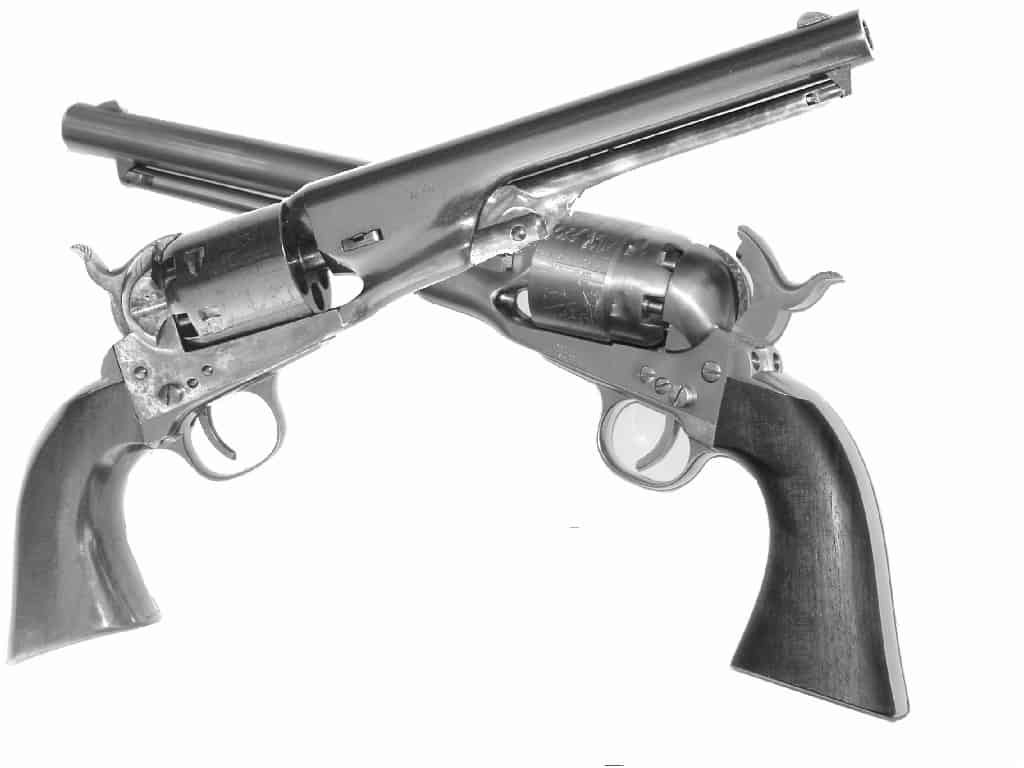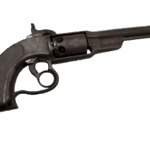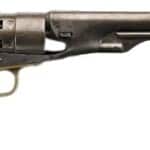
"File:Coltnewmodles.jpg" by Michael E. Cumpston is licensed under CC BY-SA 3.0.
Introduction
Few firearms have shaped American history like the Colt 1851 Navy and the Colt 1860 Army revolvers. Designed by Samuel Colt, these two cap-and-ball revolvers were not only some of the most widely used handguns of the mid-19th century but also weapons of choice for gunfighters, soldiers, outlaws, and frontiersmen. Though they share a common lineage, each revolver has distinct characteristics, strengths, and roles in history. This comprehensive analysis explores their design, performance, historical significance, and lasting legacy.
Design and Configuration
Colt 1851 Navy: A Masterpiece of Balance and Elegance
Introduced in 1850, the Colt 1851 Navy was one of the most successful percussion revolvers of its era, remaining in production until 1873. It was originally designated the "Revolving Belt Pistol of Naval Caliber," with the term "Navy" referring to its .36 caliber bore rather than any exclusive military use at sea.
- Frame & Construction:
The Colt 1851 Navy revolver featured a steel frame with a brass backstrap and trigger guard. Although Confederate manufacturers, such as Griswold & Gunnison, used brass frames due to wartime shortages, most original Colt-produced models had robust iron or steel frames for added durability. - Barrel & Grip:
With its 7.5-inch octagonal barrel, the 1851 Navy was renowned for superior balance and accuracy. It was lighter and more streamlined than previous Colt models, allowing for quick handling and precise aiming. The grip design was highly ergonomic, becoming a favorite among professional gunfighters like Wild Bill Hickok. - Cylinder Engraving:
Each factory-produced 1851 Navy revolver bore a roll-engraved battle scene depicting a famous 1843 skirmish between the Texas Navy and the Mexican fleet, a tribute to the Republic of Texas’s struggle for independence.
Colt 1860 Army: Power and Performance for the Battlefield
Ten years after the Navy’s introduction, Colt refined its design to create the Colt 1860 Army, a more powerful revolver chambered in .44 caliber. This model was the primary sidearm of Union cavalry troops during the American Civil War, with over 200,000 units produced between 1860 and 1873.
- Frame & Innovation:
Unlike the Navy, the 1860 Army featured a rebated cylinder, allowing it to fit a larger .44 caliber charge into a frame originally designed for .36 caliber. It utilized a steel frame, ensuring superior strength compared to brass-framed Confederate copies. - Barrel & Grip:
The 1860 Army had an 8-inch round barrel, slightly longer than the Navy, providing greater sight radius and improved velocity. The grip was also slightly larger, making it more controllable under recoil, a crucial factor given its heavier caliber. - Cylinder Engraving:
The roll engraving on the Army’s cylinder depicted a Texas Ranger battle with Comanche warriors, emphasizing its martial role. Some early models were produced with plain cylinders before engravings became standard.
Performance & Ballistics
The ballistics and stopping power of these revolvers differ significantly due to their respective calibers and powder charges.
Colt 1851 Navy (.36 Caliber)
- Bullet Weight: ~80 grains
- Powder Charge: ~15-20 grains of black powder
- Muzzle Velocity: ~850-950 feet per second (fps)
- Muzzle Energy: ~150-170 foot-pounds (ft-lbs)
The .36 caliber round ball of the 1851 Navy delivered adequate stopping power for its time, excelling in accuracy and penetration. Many gunfighters appreciated its fast handling and mild recoil, making follow-up shots quicker.
Colt 1860 Army (.44 Caliber)
- Bullet Weight: ~140 grains
- Powder Charge: ~30-40 grains of black powder
- Muzzle Velocity: ~750-900 fps
- Muzzle Energy: ~230-260 ft-lbs
The .44 caliber round ball fired from the 1860 Army hit harder, with greater penetration and energy transfer. This made it more effective in combat, particularly at longer ranges and against cavalry troops wearing heavy coats or body armor.
Handling and Accuracy Comparison
- The Colt 1851 Navy was lighter and more balanced, making it ideal for precision shooting and quick-draw encounters.
- The Colt 1860 Army, though heavier, delivered more power, but required firmer grip control due to greater recoil.
Famous Users & Historical Significance
Both revolvers saw extensive use in the Wild West, American Civil War, and post-war frontier expansion.
Colt 1851 Navy Users
- Wild Bill Hickok – Carried a matched pair of ivory-gripped Navy revolvers, famously using them in his legendary shootout in Deadwood, South Dakota.
- General Robert E. Lee – Was presented a gold-plated Colt 1851 Navy revolver.
- Confederate Cavalry Units – Captured and used thousands of 1851 Navy revolvers.
Colt 1860 Army Users
- General George Armstrong Custer – Reportedly carried a pair of 1860 Army revolvers during the Battle of Little Bighorn.
- Buffalo Bill Cody – Used an 1860 Army converted to fire metallic cartridges during his time as a scout and performer.
- Jesse James & Frank James – Both carried converted 1860 Army revolvers in their outlaw careers.
Alternative & Competing Revolvers
While the Colt 1851 Navy and 1860 Army were dominant, several competitors offered rival designs:
- Remington 1858 New Army – Featured a solid-frame design, making it more durable than the Colt’s open-top frame. Many soldiers preferred it for its superior strength and ability to swap cylinders quickly.
- Colt Dragoon (1848-1851) – A heavier, more powerful predecessor to the 1860 Army, chambered in .44 caliber with an even larger powder charge.
- LeMat Revolver – Used by Confederate forces, featuring a unique secondary shotgun barrel beneath the main revolver barrel.
The Legacy of the Colt 1851 Navy & 1860 Army
The Colt 1851 Navy and 1860 Army revolvers remain two of the most iconic percussion revolvers in American history. Their influence extended into the cartridge era, with many being converted to fire metallic ammunition (.38 Colt and .44 Colt). They set the stage for the Colt Single Action Army of 1873, which became the definitive firearm of the American West.
For collectors, shooters, and historians alike, these revolvers are more than just relics—they represent the evolution of firearm technology, the spirit of the frontier, and the ingenuity of Samuel Colt. Whether displayed in museums, shot on the range, or admired in films and reenactments, their place in history remains unrivaled.
Read more here:
Discussion groups on these weapons can be found here and here.
If you know of any forums or sites that should be referenced on this listing, please let us know here.







